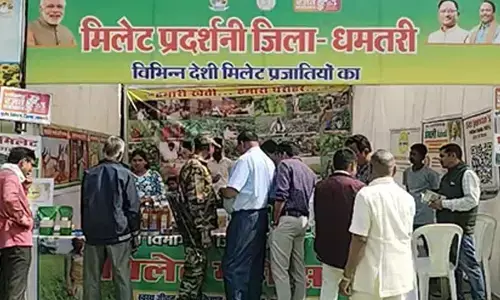An overview on PMFBY in India

Pradhan Mantri Fasal Bima Yojana (PMFBY) is the new crop insurance scheme launched by Central Government in January 2016 to replace the existing two schemes National Agricultural Insurance Scheme (NAIS) as well as Modified NAIS which have had some inherent drawbacks.
Pradhan Mantri Fasal Bima Yojana (PMFBY) is the new crop insurance scheme launched by Central Government in January 2016 to replace the existing two schemes National Agricultural Insurance Scheme (NAIS) as well as Modified NAIS which have had some inherent drawbacks.
Pradhan Mantri Fasal Bima Yojana scheme will be implemented in every state of India, with association with the respective State Governments. This crop insurance scheme will be administered under the Ministry of Agriculture and Farmers’ Welfare, Government of India.
Previous Crop Insurance Schemes
1985- Comprehensive Crop Insurance scheme
1999- National Agricultural Insurance Scheme
2007- Weather based crop insurance scheme
2010- Modified National Agricultural Insurance Scheme
Government policies and interventions for development in various sectors and issues arising out of their design and implementation.
Welfare schemes for vulnerable sections of the population by the Centre and States and the performance of these schemes
Need for PMFBY
Indian agriculture is reeling at the menace of twin droughts following El-Nino phenomenon and untimely Rabi season rains and hailstorms. It is against this backdrop, that a crop insurance scheme to deal with risks associated with weather fluctuation is imperative for alleviating the distress caused to the farmers.
Also, at present, only 23 % of cropped area in India has access to insurance. According to sources, Pradhan Mantri Fasal Bima Yojana will increase the insurance coverage to 50 per cent of the total crop area of 194.40 million hectare from the existing level of about 25—27 per cent crop area. The expenditure is expected to be around Rs 9,500 crore.
Features of PMFBY
- The scheme covers kharif, rabi crops and commercial and horticultural crops as well.
- The premium charged for kharif crops would be up to 2% of the sum insured and for rabi crops it would be up to 1.5% of the sum assured.
- For annual commercial and horticultural crops, the premium would be 5 per cent.
- To provide insurance to the farmers at a subsidized rate of premium, the remaining share will be borne equally by the central and respective state governments.
- This scheme will cover post-harvest losses also and provide farm level assessment for localised calamities including hailstorms, unseasonal rains, landslides and inundation.
- To fasten the process of claims, the scheme proposes mandatory use of remote sensing, smart phones and drones for quick damage assessment.
Objectives of Pradhan Mantri Fasal Bima Yojana
- To provide insurance coverage and financial support to the farmers in the event of failure of any of the notified crop as a result of natural calamities, pests & diseases.
- To stabilise the income of farmers to ensure their continuance in farming.
- To encourage farmers to adopt innovative and modern agricultural practices.
- To ensure flow of credit to the agriculture sector.
Problems with NAIS and MNAIS
The NAIS and the MNAIS were not serving the farmers’ interests well and suffered from following lacunae:
- The sum insured under MNAIS, particularly for risky crops and districts, was meager and was based either on the quantum of crop loans or on the capping of the sum insured.
- The crop damage assessment method based on crop cutting experiments was very slow and time-consuming.
- The time taken for compensation to reach the farmers often ran into several months.
Improvements via PMFBY
To overcome the problems and the weaknesses of the NAIS and MNAIS, the government decided to incorporate following essential elements in the new scheme:
- A technical committee was proposed to be set up in each district to decide the scale of finance for the sum insured.
- The premiums are to be decided on an actuarial basis which would give credibility to the process of setting premiums.
- Bids are invited from public and private insurance companies to decide the premiums, thus adding an element of competition which would work in the favor of the farmers.
The farmers were required to pay the premiums at a subsidized rate and rest is paid by the government as mentioned above.
Use of technology such as smart phones, GPS, drones and satellites to ensure accuracy, transparency, and faster assessment of damages and settling claims.
Implementing Agency (IA) of PMFBY
PMFBY will be implemented by multiple insurance companies under overall control of Ministry of Agriculture & Farmers Welfare.
The Ministry designated/empanelled Agriculture Insurance Company of India (AIC) and some private insurance companies presently to participate in the Government sponsored agriculture /crop insurance schemes.
The choice private company is left to the states. There will be one insurance company for the whole state.
Management of the scheme
The existing State Level Co-ordination Committee on Crop Insurance (SLCCCI), Sub-Committee to SLCCCI, District Level Monitoring Committee (DLMC) already overseeing the implementation & monitoring of the ongoing crop insurance schemes like National Agricultural Insurance Scheme (NAIS), Weather Based Crop Insurance Scheme (WBCIS), Modified National Agricultural Insurance Scheme (MNAIS) and Coconut Palm Insurance Scheme (CPIS) shall be responsible for proper management of the Scheme.
Unit of Insurance
The Scheme shall be implemented on an ‘Area Approach Basis’. For major crops, the Unit of Insurance shall ordinarily be Village/Village Panchayat level and for minor crops may be at a higher level depending upon the requirement.
Farmers to be covered
All farmers growing notified crops in a notified area during the season who have insurable interest in the crop are eligible.
Compulsory Coverage
The enrolment under the Pradhan Mantri Fasal Bima Yojana scheme, subject to possession of insurable interest on the cultivation of the notified crop in the notified area, shall be compulsory for following categories of farmers:
- Farmers in the notified area who possess a Crop Loan account/KCC account (called as Loanee Farmers) to whom credit limit is sanctioned/renewed for the notified crop during the crop season.
- Such other farmers whom the Government may decide to include from time to time.
Premium Rates
The Actuarial Premium Rate (APR) would be charged under PMFBY by insurance agencies. Govt. of India/States will monitor (and not fix) the premium rates considering
- The basis of Loss Cost (LC) i.e. Claims as % of Sum Insured (SI) observed in case of the notified crop(s) in notified unit area of insurance during the preceding 10 similar crop seasons (Kharif / Rabi)
- expenses towards management including capital cost and insurer’s margin
- taking into account non-parametric risks and reduction in insurance unit size etc..
Impact of PMFBY
To know the impact and the results achieved due to the introduction of this scheme, it is essential to know a few numbers in comparison to the erstwhile insurance schemes performance in Kharif 2013 and Kharif 2015.
Farmers Insured
The number of farmers insured under the PMFBY rose by 193% over Kharif 2013 and by 0% over Kharif 2015. The number of non-loanee farmers also increased by more than six times.
Area Covered
The area insured also increased from 16.5 million hectares (mha) in kharif 2013 and 27.2 mha in kharif 2015 to 37.5 mha under PMFBY.
Sum Insured
The sum insured has witnessed a huge rise and has gone up from Rs 34,749 crores in kharif 2013 to Rs 60,773 crores in kharif 2015, and now to Rs 1,08,055 crores under PMFBY.
Challenges faced by PMFBY
PMFBY has also had its own share of challenges and shortcomings in terms of implementation. These need to be ironed out to ensure that the scheme serves the farmers well and at a lower cost. Few of the problems faced by PMFBY have been:
- This scheme has witnessed an increase in the actuarial premium, instead of coming down with the increasing scale of coverage. A major reason for this is high price charged by various insurance companies to increase their profits. The competition in the upcoming seasons will reduce this rate of premium and reduce cost to the government.
- Areas in eastern Uttar Pradesh, Bihar and Assam which faced floods and subsequent loss to farmers saw inspections being done by human eye.
- Drones were not employed and smart phones which had to be issued to field officials, as per guidelines, were also not issued.
- States failed to pay premiums to companies in advance in many cases.
- There has also been a delay in compensating the farmers.
- The scheme does not cover the risks and losses inflicted by wild animals like elephants and wild boars which is a major problem in certain states.
















